All Bustards Great and Small: Birdwatching in Extremadura
The Full Story!
Saturday 9th March
Our tour began at Madrid Airport. We quickly picked up our comfortable 9-seater minibus and after a little confusion on the motorways around Madrid, we found ourselves heading southwest towards Extremadura. We hadn’t gone far before we encountered our first great birds of the trip: a flock of 40 Common Cranes came sweeping over the road and passed low overhead. What a magnificent spectacle! White Storks soon became a common sight both in the air above and standing majestically in fields on either side of the road. Both Red and Black Kites were added to our growing bird list. Then some major excitement as we saw our first Black-shouldered Kite hovering close to the main road. What a wonderful bird to encounter so early in the trip. Amazingly we soon encountered a second Black-shouldered Kite this time much closer and on a quieter stretch of road so we were able to enjoy a much better view. Large flocks of Lapwings in the fields reminded us that many of the winter birds were still present here in early spring.
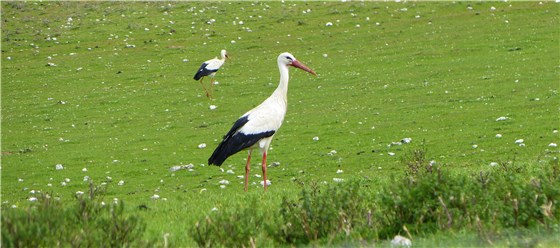
White Storks
Our first stop was at a wetland area not far off the main road and we immediately experienced bird overload! One of those brilliant birdwatching moments when everyone is calling out new and exciting birds and it’s difficult to know which way to look first! Giant Purple Gallinules worked the reed edge; Kingfisher whizzed past; Zitting Cisticola was singing above the reeds; Great White, Little and Cattle Egrets were all here; a Glossy Ibis dropped in; Marsh Harrier drifted over the wetland as Crested Larks sang all around. But the best was still to come when we saw a Great Spotted Cuckoo flying low over the reedbed pursued by angry magpies. Luckily the Great Spotted Cuckoo crash-landed in the top of a nearby willow tree and began calling. This was just brilliant: two of our target birds, the Great Spotted Cuckoo and the Black-shouldered Kite, had already been seen very well and we hadn’t even reached our destination yet! Just as we were about to set off to continue our journey, we saw a beautiful Black-shouldered Kite hunting over the adjacent fields. We soaked up the views of this tiny, almost owl-like raptor in the late afternoon sun, just brilliant!
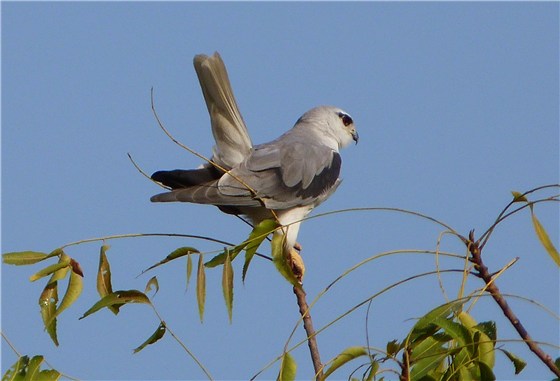
Black-shouldered Kite
Back on the main road, we made good time down to Trujillo and were soon at our lovely country hotel. As always, we were greeted warmly by our hosts Martin and Claudia, and once settled in to our lovely warm rooms we were treated to a wonderful home-made dinner and enjoyed the local red wine as we reminisced over the day’s birds.
Sunday 10th March
After our lovely breakfast, we didn’t get very far as stepping out from the hotel we were greeted by a Hawfinch in the top of one of the garden trees. Stopping to watch this wonderful bird we noticed a gang of Azure-winged Magpies in the trees across the lane. Not a bad start! A short drive took us to the bullring at Trujillo. Here we were soon watching Lesser Kestrels on the broken tiled roof. The views were wonderful through the Leica scope, every tiniest detail could be seen even down to the pale claws of the females. Alongside the Lesser Kestrels were oily Spotless Starlings, again allowing scope-filling views. We headed west from the ancient town of Trujillo and soon found ourselves in an area of woodland where we stopped to admire nesting White Storks right by the road. Of course, once you stop for one bird in this amazing part of Spain, you quickly discover other species. A Woodlark circled overhead pouring out its beautiful melancholy song, gangs of Azure-winged Magpies swooped across the track, a male Sardinian Warbler popped up on a dead bush and Serins gave their tinkling calls all around us.
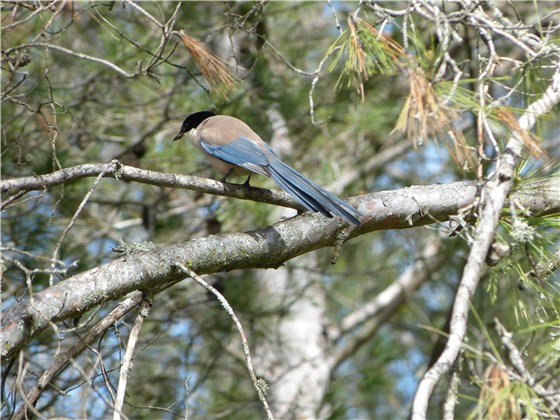
Azure-winged Magpie
We moved on to where the woodland ended and a rolling grass plain stretched out before us to the far horizon. This edge habitat proved a perfect place to stop and scan. Ahead of us over the plains large Calandra Larks rose against the blue sky singing loudly and showing off their black underwings complete with a white trailing edge. A Red Kite drifted right over us as a noisy flock of Spanish Sparrows descended to feed around a cattle trough in the field next to us. This flock of sparrows also held at least six Rock Sparrows which we were very pleased to see as this bird can be difficult to find. We slowly drove along the narrow track constantly scanning the plains for new birds. We hadn’t gone far when we spotted an amazing flock of 70 Pin-tailed Sandgrouse quietly feeding on an open area of plain. We quickly set up the scopes and enjoyed wonderful views of these beautifully plumaged birds. All around us were more Calandra Larks, Crested Larks, Wheatears, White Storks and a Southern Grey Shrike. It was some time before we noticed the three Great Bustards standing in the field behind us! Had they been there all the time? There was just so much to see that it was simply mind-blowing birding. The Great Bustards allowed superb views through the telescopes in the morning sunshine.
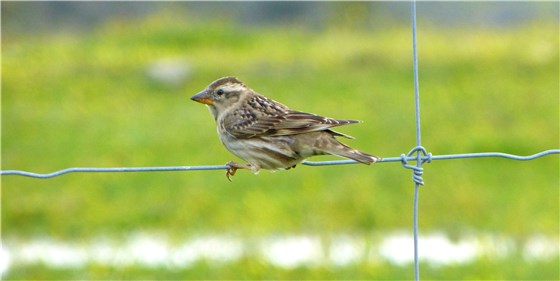
Rock Sparrow
Moving on we took another track into an area of rolling farmland and again progress was very slow as we continually stopped to watch great birds. Here we found large numbers of Black-bellied Sandgrouse but these birds were always seen in flight as they swept over the plains at high speed though at least it allowed great views of their distinguishing feature. More Pin-tailed Sandgrouse were also using this part of the plain and here we were joined by a large flock of Golden Plover. We found seven more Great Bustards along this track as they stood on a ridge looking very impressive against the dark clouds that were building in the distance. With rain threatening it seemed a good time to have a coffee in the nearby village and we enjoyed some great hospitality in the tiny bar/café.
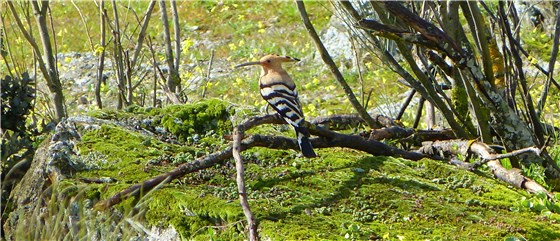
Hoopoe
We were soon back on the road and birded our way across another area of rolling plain stopping every time we came across more good birds. We enjoyed great looks at both Black and Griffon Vultures, a beautiful ghostly male Hen Harrier, Little Owls in a nestbox and more Lesser Kestrels and again both species of Sandgrouse. We then headed slowly back towards Trujillo birding the wildflower-filled fields. We hadn’t gone very far along this road when we spotted four male Little Bustards in one of the meadows near the road. We set up the scopes and were just enjoying the views when the heavens opened. Those dark clouds had found us. Of course we continued birding, mostly from the minibus, and enjoyed good views of Stone Curlews, Green Sandpiper, lots more White Storks and a small wetland added Gadwall and Teal to our trip list. We finished the day out on the plains near Belen seeing more Stone Curlews, Lesser Kestrels, Calandra Larks, a Peregrine Falcon and both Black and Griffon Vultures. We also enjoyed Iberian Hares and a good look at a Fox. As we drove back to our hotel, an Egyptian Vulture flew low overhead – a nice way to finish the day.
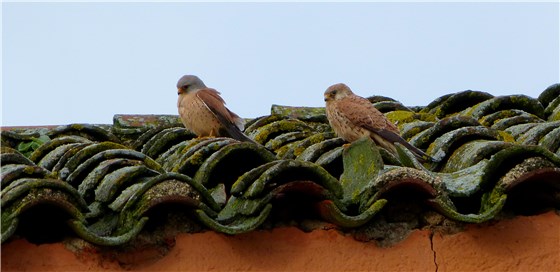
Lesser Kestrels on the bullring roof
Monday 11th March
This morning we changed things around and went for a pre-breakfast walk along the lanes around the hotel. This provided some great Spanish birds. Azure-winged Magpies were seen frequently, Sardinian Warblers gave their machine-gun-like calls from the scrub, Hoopoes were both seen and heard, Serins were one of the commonest birds, two Firecrests showed in a large pine but a Short-toed Treecreeper proved very elusive only showing very briefly. Both Red Kite and Sparrowhawk flew over. After our delicious breakfast we drove north towards the Monfrague National Park. As ever progress was slow as there were just so many birds to see along the way. We stopped at a river bridge to watch Red-rumped Swallows and soon added Crag Martins, Short-toed Eagle and Black Stork to our already impressive bird list.
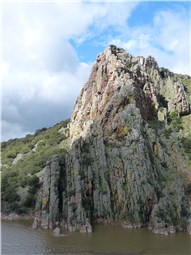
Pena Falcon Rock, Monfrague National Park
In the park itself, the raptors were just waking up and taking to the air around the famous Pena Falcon rock. The views of the Griffon Vultures were spectacular. You almost felt you could reach out and touch them, they were passing so close at eye-level. Black Storks were also on the wing soaring around the rock face and as we watched two of these pterodactyl-like birds landed on the cliff allowing wonderful scope views. As we watched the storks, we noticed two Egyptian Vultures sitting on the cliff face above them. The morning sunlight really showed off their vivid yellow faces and bills. A Goshawk cruised overhead, an unexpected bonus at this site, Black Redstarts and Serins flitted around the rocks and then we spotted a handsome male Blue Rockthrush down near the base of the cliff. Through the Leica telescope we could see that the thrush had caught a very large gecko-like lizard almost as big as the bird itself. We watched spellbound as the thrush tried to swallow the lizard head-first. It took some 15 minutes but eventually all that was left to see were the lizards back legs protruding from the sides of the thrush’s bill, quite an amazing thing to witness!
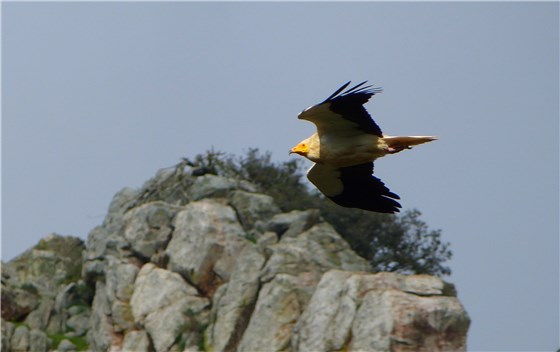
Egyptian Vulture
We then moved on to spend some time birdwatching in an area of mixed woodland where we enjoyed great looks at Crested tits, Firecrests, Cirl Buntings and four Red Deer. We slowly birded our way back to Trujillo seeing lots more raptors and stopped off at the bullring for another encounter with the Lesser Kestrels. This time there were at least 13 of these lovely falcons either sitting on the roof or circling right above us. The light was better than our first encounter and everyone really enjoyed these gorgeous colourful birds of prey. Again the kestrels were sharing the bullring with noisy flocks of Spotless Starlings. At the nearby park lake we found two newly arrived Little Ringed Plovers and a large mixed flock of Swallows and House Martins.
Tuesday 12th March
A quick pre-breakfast look around the village produced three Red-rumped Swallows, the first of the spring at this site. These gorgeous hirundines were sitting on a telegraph wire allowing us to really enjoy their colours. Above them a pair of White Storks were refurbishing their large nest on the church tower. A Black Redstart was feeding in the field behind the church and two Hawfinches flew over and a gang of Azure-winged Magpies were in the trees near the hotel. Another lovely breakfast was enjoyed before heading out for the plains. Today we were joined by our host and local bird expert, Martin Kelsey, so we knew we were in for a great day’s birdwatching. We returned to the plains west of Trujillo and were soon enjoying more great looks at the large flock of Pin-tailed Sandgrouse. The morning light was beautiful and their colours really sang out. A Southern Grey Shrike sang from a roadside bush, flocks of Golden Plover wheeled overhead as both Black and Red Kites drifted by. We also enjoyed comparing larks as we had Thekla, Crested, Sky- and Calandra Lark all in view at the same time.
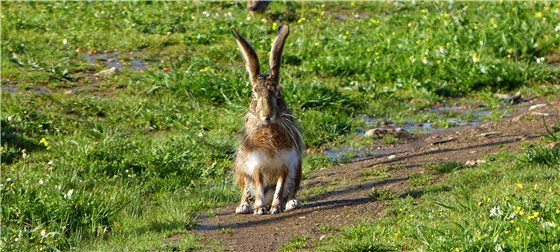
Iberian Hare
We again took the track off the minor road and we soon hit Great Bustards galore! We were amazed and delighted to see at least 50 Great Bustards striding across the rolling grasslands. Three of the males then began displaying, turning themselves inside out so they looked like huge white bubble baths out on the grassland, what a staggering sight. A group of 22 male Great Bustards put on a parade for us marching in single file up to the top of a hill and back down again, a very odd sight indeed. This time, we were lucky with the Black-bellied Sandgrouse as we found a small flock feeding on the bare ground and these allowed wonderful scope views. Lots more Sandgrouse of both species were hurtling across the skies above us. Then most unexpectedly, a familiar call reached our ears as a Greenshank flew over the plains. Corn Buntings as ever were all over the area and their wonderful jangling calls were a constant feature of our time on the plains. We again visited the bar in the local village to enjoy welcome hot drinks as it was pretty chilly out on the plains despite the sunshine.
We then took a road back towards Trujillo stopping to admire a male Woodchat Shrike, three Kingfishers together, more Cirl Buntings, Woodlarks, Black and Griffon Vultures and a lovely Short-toed Eagle. From Trujillo we headed south to a large reservoir where we enjoyed another delicious picnic lunch (thank you Claudia!). Of course the birding didn’t stop just because we were eating and we were able to admire displaying Great Crested Grebes out on the lake, Lesser Kestrels and Little Owl on a derelict barn and all eating stopped as we stood in admiration as a flock of at least 60 Black Kites drifted slowly north overhead. What a wonderful sight! Along with the kites, large numbers of White Storks were also heading north and a gang of Pallid Swifts passed over as a beautiful male Marsh Harrier hunted the edge of the reservoir. On the far side of the reservoir were masses of wildfowl, mostly Shoveler but also Gadwall, Pintail and a small flock of Red-crested Pochards. Two Common Cranes were feeding in a nearby field and we had great views of these massive birds before they took to the air and also headed north. Migration was happening all around us.
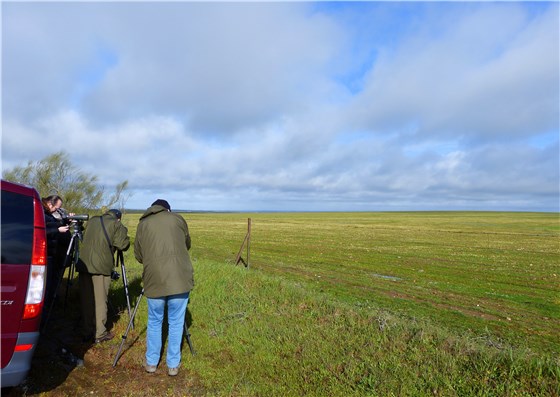
Plains outside Trujillo
Next we took a minor road aross another area of rolling steppe habitat and we soon found what we were looking for: Bustards, and lots of them! Great Bustards were feeding in the fields on both sides of the road, and the afternoon sunshine really showed off their beautiful orange and grey necks and the bizarre white moustaches of the males. Just a little further along the road we were able to watch a flock of 70 Little Bustards loafing about in a flower-filled meadow. The black-and-white neck patterns of the males really stood out in the excellent light. Calandra Larks were everywhere pouring out their song from high above the grasslands. White Storks, both Black and Red Kites and both Black and Griffon Vultures all soared above us, what a wonderful place. Further along this same road we encountered a flock of eight Stone Curlews, five more Great Bustards, singing Thekla Lark and lots more Great Bustards. With the sun sinking we headed back to our wonderful hotel to enjoy another fabulous home-cooked dinner, raising a glass in thanks to Martin for his great company and tremendous knowledge of the local birds and their habitats.
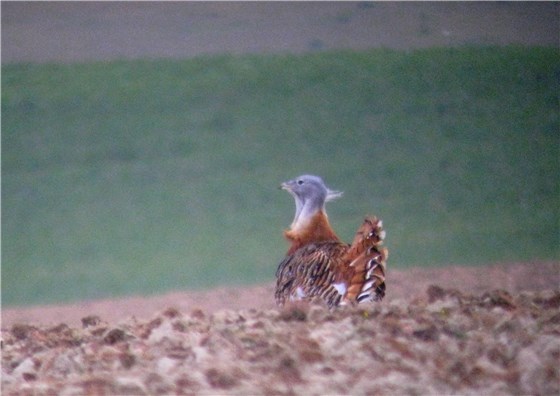
Great Bustard
Wednesday 13th March
Sadly our time in Extremadura had flown by and it was time to leave. We said a huge thanks and farewell to Martin and Claudia and set off back towards Madrid. We hadn’t gone far when we saw two Great Spotted Cuckoos alongside the road, keeping up our record of seeing this enigmatic species every day of the trip. Of course we couldn’t stop birding so we called in at the wetland where we had begun our Spanish birding. Despite the clear blue sky and sunshine there was a really cold wind which reduced the bird activity somewhat. However, with a little persistence we were soon enjoying some wonderful birds. A Squacco Heron had found a sheltered spot in a reed-fringed bay and we had great views through the scopes. A Black-shouldered Kite was hunting over a flower-filled meadow beyond the lagoon and it was here we noticed a cortege of Griffon Vultures on the ground by a sheep carcase. We looked up and saw more and more vultures gliding in towards the carcase. Amongst the dozens of Griffon Vultures were two huge Black Vultures which literally bounced onto the field next to the Griffons. It was fantastic to see these enormous birds on the deck. Purple Gallinules were again feeding around the base of the reedbeds and a Savi’s Warbler was reeling unseen from the reeds. A male Subalpine Warbler put in a brief appearance and a Willow Warbler was amongst large numbers of Chiffchaffs feeding in the waterside vegetation.

Great Spotted Cuckoo
All too soon it was time to head for the airport and our afternoon flights back to the UK. A Green Woodpecker that flew across the ring road in Madrid was our last addition to the trip list. We had recorded a very pleasing 130 species during our trip, but more importantly we had enjoyed wonderful views of the key species in this beautiful part of Spain. We will certainly be returning to Extremadura again and again.
Highlight species of this five-day tour included:
Cattle Egret, Great White Egret, Little Egret, Squacco Heron, White Stork, Black Stork, Glossy Ibis, Red-crested Pochard, Black Kite, Red Kite, Egyptian Vulture, Griffon Vulture, Black Vulture, Short-toed Eagle, Marsh Harrier, Hen Harrier, Goshawk, Spanish Imperial Eagle, Golden Eagle, Lesser Kestrel, Peregrine Falcon, Merlin, Black-shouldered Kite, Purple Gallinule, Common Crane, Little Bustard, Great Bustard, Stone Curlew, Little Ringed Plover, Green Sandpiper, Greenshank, Black-bellied Sandgrouse, Pin-tailed Sandgrouse, Great Spotted Cuckoo, Scops Owl, Little Owl, Pallid Swift, Kingfisher, Hoopoe, Green Woodpecker, Calandra Lark, Crested Lark, Thekla Lark, Woodlark, Crag Martin, Red-rumped Swallow, Yellow Wagtail, White Wagtail, Black Redstart, Stonechat, Wheatear, Blue Rockthrush, Cetti’s Warbler, Savi’s Warbler, Sardinian Warbler, Subalpine Warbler, Zitting Cisticola, Firecrest, Crested Tit, Short-toed Treecreeper, Southern Grey Shrike, Woodchat Shrike, Azure-winged Magpie, Spotless Starling, Spanish Sparrow, Rock Sparrow, Serin, Hawfinch, Cirl Bunting, Corn Bunting.
If you’d like to join us for some exciting Extremadura birding in April 2014, email us for more information on
info@thebiggesttwitch.com. We look forward to sharing some great Spanish birds with you!